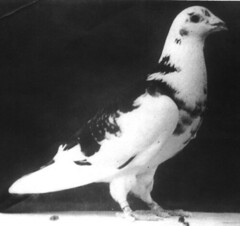
About UsThe Numismatic Bibliomania Society is a non-profit organization promoting numismatic literature. For more information please see our web site at coinbooks.org SubscriptionsThose wishing to become new E-Sylum subscribers (or wishing to Unsubscribe) can go to the following web page link MembershipThere is a membership application available on the web site Membership Application To join, print the application and return it with your check to the address printed on the application. Membership is only $15 to addresses in the U.S., $20 for First Class mail, and $25 elsewhere. For those without web access, write to: David M. Sundman, Secretary/TreasurerNumismatic Bibliomania
Society AsylumFor Asylum mailing address changes and other membership questions, contact David at this email address: dsundman@LittletonCoin.com SubmissionsTo submit items for publication in The E-Sylum, just Reply to this message, or write to the Editor at this address: whomren@coinlibrary.com
BUY THE BOOK BEFORE THE COINYou won't regret it! |
- WAYNE'S WORDS: THE E-SYLUM OCTOBER 28, 2012
- NEW BOOK: ECUADOR COINS – A POCKET CHECKLIST
- BOOK REVIEW: GRADING COINS BY PHOTOGRAPHS, 2ND EDITION
- INTERVIEW WITH SIAMESE COINS AUTHOR RONACHAI KRISADAOLARN
- THE ANS LIBRARY WISH LIST
- MONUMENT UNVEILING FOR F. GORDON FROST
- NEW YORK DEALER JOEL COEN
- 1962 SEATTLE WORLD'S FAIR NUMISMATIC SOUVENIRS
- NOTES FROM E-SYLUM READERS: OCTOBER 28, 2012
- BILL ROSENBLUM'S NUMISMATIC TRAVEL TIDBITS
- LIBERTY DOLLAR FOUNDER VON NOTHAUS AWAITS HIS FATE
- LIBERTY DOLLARS VS COMMUNITY CURRENCY
- ATTORNEY CAN FILE SUITS AGAINST GRADING SERVICES
- NEW LAWSUIT AGAINST NATIONAL GOLD EXCHANGE OWNERS
- STACKS-BOWERS NOVEMBER 2012 BALTIMORE AUCTION LOTS
- WHERE WAS THE CONTINENTAL CURRENCY COINAGE MADE?
- BLESSED ARE THOU, BIBLIOGRAPHY
- FAIRBANKS NATIONAL BANK NOTE SELLS
- OREGON TOWN USED TOKEN TO RELIEVE 1964 COIN SHORTAGE
- MORE ON THE ST ALBANS ROMAN GOLD COIN HOARD
- THE MINT MUSEUM AT HALL IN TYROL
- AFGHANISTAN BOMB-DETECTING DOG WINS DICKIN MEDAL
- THE COLLECTING ADDICTION: A NEW COLLECTOR IS BORN
- A BENCH MADE FROM BOOKS
- FEATURED WEB PAGE: FORGERY NETWORK
WAYNE'S WORDS: THE E-SYLUM OCTOBER 28, 2012

New subscribers this week include Bryan Caforio. Welcome aboard! We have 1,602 email subscribers, plus 194 followers on Facebook.
Tonight much of the Eastern U.S. is bracing for a major storm in the wake of Superstorm Sandy. Here at my house we've stocked up on water, batteries and other supplies in case of a prolonged power outage. I don't know if the next E-Sylum issue will be affected, but please be patient if it doesn't arrive in your inbox. Be safe, everyone.
This week we open with a new book on coins of Ecuador, a review of Grading Coins by Photographs, and a video interview with the author of Siamese Coins. Other topics include the Continental currency coinage, New York dealer Joel Coen, travel notes from Bill Rosenblum, and multiple articles on various lawsuits and legal problems in the hobby.
To learn more about Alphonse Mucha's banknote designs, Bernard von NotHaus' Malibu retreat, the "axial ultimate refractory angle of the coin", numismatic souvenirs of the 1962 Seattle World's Fair, Centesimus Undequinquagesimal Anniversaries and Gordon frost's weighty tome, read on. Have a great week, everyone!
Wayne Homren
Editor, The E-Sylum
NEW BOOK: ECUADOR COINS – A POCKET CHECKLIST
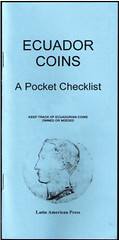 ECUADOR COINS – A Pocket Checklist
is a 40 page, 4 by 8 inch booklet that can easily be carried in a back pocket
or the pocket of a sport coat. It allows the collector to record all items
owned so that he/she can determine at a glance, the coins needed to
complete his/her collection. There is enough space provided so that prices
and grades can be written down as well as notes about significant offerings.
The book can be used by either date collectors or type collectors.
ECUADOR COINS – A Pocket Checklist
is a 40 page, 4 by 8 inch booklet that can easily be carried in a back pocket
or the pocket of a sport coat. It allows the collector to record all items
owned so that he/she can determine at a glance, the coins needed to
complete his/her collection. There is enough space provided so that prices
and grades can be written down as well as notes about significant offerings.
The book can be used by either date collectors or type collectors.
It includes all Ecuadorian issues from the proto-coinage used before the first coins were struck in Quito through the coins issued after the Dollarizacion. The cover of the book bears the effigy of Simon Bolivar as found on many early Ecuadorian coins. The book starts with Introduction/ Comments to include brief comments about available literature such as the Krause catalogs, and the detailed histories by Anderson and Hoyos. A short table on abbreviations used in the book finishes this first section.
The book is roughly divided into logical sections which are essentially chronological with the exception that silver and base metal coins are clearly separated from gold issues and the very early, counter stamped issues and/or non-standard issues are placed in separate sections at the rear of the book.
The delineated sections are as follows;
Introduction/Comments
Pre-Decimal Silver Coinage
Decimal Silver and Base Metal Coinage
Pre-Decimal Gold Coinage
Decimal Gold Coinage
Decimal Patterns and NCLT Coinage
Early and Unusual Coinage including the various
Counterstamped, Pattern, Offmetal and Mint Sport issues.
Various recent “coins” struck for the Galapagos
The book finishes with a seven page section on the grading of Ecuadorian coins. It not only has several pages of verbal descriptions of the various grades but includes photos of about fifteen Ecuadorian coins in various states of preservation.
Due to the omnipresence of The Standard Catalog of World Coins, in its many guises, all of the issues in this booklet are tied to KM numbers where possible. As the Krause series of books is now the world standard it would have been a disservice to collectors to do otherwise. The KM catalog numbers from that series of books are now used throughout the world by collectors from most countries. Those catalogs are available from the publisher, Krause Publications in Iola, WI USA or from many dealers that specialize in world coinage
The price of this forty page booklet is ten dollars postpaid to U.S. and Canada. All other countries add two dollars to cover additional postage. Order from: Dale Seppa, 103 N. 6th Avenue, Virginia, MN 55792. PayPal payments with credit card can be made at www.paypal.com – Recipient for PayPal payments is daleseppa@gmail.com
DEALER PRICES (All postpaid in Canada or U.S.)
1 Copy $8.00 (Add two dollars for foreign delivery)
10 Copies $60.00 (Add ten dollars for foreign delivery)
50 Copies $200.00 (Add 50 dollars for foreign delivery)
Insurance or registration is not included in the postpaid price. If desired, add two dollars for insurance for orders delivered in the United States or Canada. Registration to foreign countries is now $13.75 per package and we do not have any responsibility for delivery to foreign countries whether or not the package is registered.
BOOK REVIEW: GRADING COINS BY PHOTOGRAPHS, 2ND EDITION
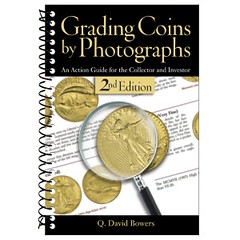 Grading Coins by Photographs – An Action Guide for the Collector and Investor, 2nd Edition, 2012, Q. David Bowers, Whitman Publishing, LLC. Reviewed by, John and Nancy Wilson, NLG
Grading Coins by Photographs – An Action Guide for the Collector and Investor, 2nd Edition, 2012, Q. David Bowers, Whitman Publishing, LLC. Reviewed by, John and Nancy Wilson, NLG
The 2nd Edition of Grading Coins by Photographs by well-known numismatist Q. David Bowers was recently released by Whitman Publishing, LLC. The spiral bound reference is 6 X 9 inches, has 384 pages and is fully illustrated in high-resolution color for each grade plus Proofs. Like all Whitman references, Grading Coins by Photographs is laid out in an easy to follow and read manner. All federal coinage is covered from half cents to double eagles.
He has taken his 1st Edition and updated it, and greatly improved the photos. The history of grading is covered in depth and explains how we got to where we are in grading now. Chapter 4 covers the surfaces of coins and how they affect the grade. Much money can be lost if the surface of the coin is not considered carefully.
The preview preceding each coin along with the photographs in this location are very helpful. This second edition gives a fresh insight into today’s grading standards. Special consultants to the book are Kenneth E. Bressett and Bill Fivaz. Many great quotes are in David M. Sundman’s Foreword. Here are just a few from David that we think are great: “As you learn to grade coins accurately with the help of this book: You will learn to look at the coin itself, ignoring the grading label on its holder. You will learn to cherry pick coins that are exceptional specimens for your collection. You will be a confident and more knowledgeable buyer.”
The first six chapters cover in 40 pages the field of grading in general. From page 40 to the end of the book on page 363, every denomination and year of coinage is covered separately with good photographs of each condition along with written observations about each condition for that date.
We thoroughly enjoyed reading this reference. We think it will help us grade, buy or sell coins in a well-informed manner. Mr. Bowers has once again written another “best-selling” reference. We highly recommend it to beginning and advanced collectors.
The 2nd Edition of Grading Coins by Photographs is priced at $19.95. It is available from the publisher at: Whitman Publishing, LLC, 3103 Clairmont Rd., Suite B, Atlanta, GA. 30329 or call (800) 546-2995 or visit their web site, www.whitmanbooks.com
INTERVIEW WITH SIAMESE COINS AUTHOR RONACHAI KRISADAOLARN

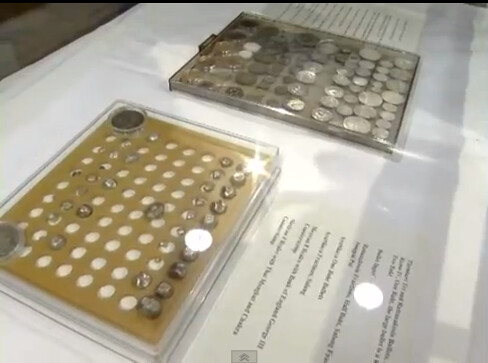
To watch the interview, see:
Siamese Coins From Funan to the Fifth Reign
(www.afgventuregroup.com/dispatches/south-east-asia-and-india
/siamese-coins-from-funan-to-the-fifth-reign/)
To read an earlier E-Sylum article, see: BOOK REVIEW: SIAMESE COINS, FROM FUNAN TO THE FIFTH REIGN (www.coinbooks.org/esylum_v15n41a07.html)
THE ANS LIBRARY WISH LIST

The ANS Library has recently updated a section of the ANS library support website. Library staff frequently get inquiries from people wishing to donate their auction catalogs. Because of space limitations here, we cannot accept all donations of every catalog, so we have prepared some listings of specific catalogs and runs of catalogs that we would very much like to acquire. Perhaps our members can help. The lists that are posted are of our MISSING catalogs (i.e. those we would like to acquire). This information will be updated as it becomes necessary.
For more information, see: Wish List for the ANS Library (numismatics.org/Library/WishList)
MONUMENT UNVEILING FOR F. GORDON FROST
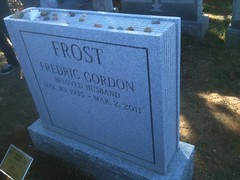 A group of Gordon's friends and relatives gathered on Sunday, October 21, 2012, to unveil his monument in Beth David Cemetery in Elmont, Long Island (just over the border from New York City in Nassau County).
A group of Gordon's friends and relatives gathered on Sunday, October 21, 2012, to unveil his monument in Beth David Cemetery in Elmont, Long Island (just over the border from New York City in Nassau County).
Rosalie Frost chose a very appropriate shape for the monument - a book. This monument shape is an uncommon one known as the "Book of Life" and it is used for grave monuments in both Judaism (Sefer HaChaim) and Christianity.
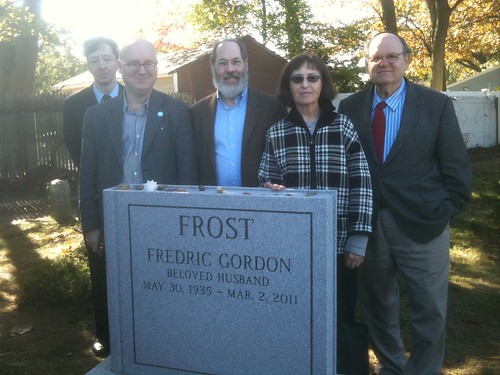
The persons in the photograph are, from left to right, Normand Pepin, John Kleeberg, Scott Miller, Rosalie Frost, and Dr. Ira Rezak (who took most of the photographs - the above one was taken by Scott's wife, Roz Miller).
The pages on the book are divided into six sections, which Ira suggested may refer to the six divisions of the Mishnah. There are no head and foot bands (well head bands, at any rate - I wasn't able to flip it over to see the foot bands). Quite a weighty tome.
To read an earlier E-Sylum article, see: GORDON FROST 1935 - 2011 (www.coinbooks.org/esylum_v14n10a02.html)
NEW YORK DEALER JOEL COEN
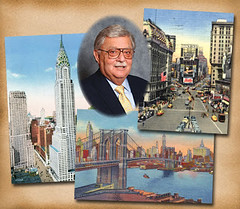 I'm so happy for Mr. Stack - his life must truly be complete, what a marvelous feeling it must be to wake up & do business in the "Coin Capital Of The World". It has one envisioning used empty 2x2 coin holders & flips wistfully blowing down sidewalks as collectors upgrade their holdings, children's noses pressed against storefront windows gleaming with brilliant displays, cheerful staff explaining the subtle nuances of toning, grading, mintmarks - Ah Joy. A numismatic nirvana and if given the choice, the afterlife we would all choose to spend eternity in. London may boast Spink (founded in 1666) and Europe has numerous very large collections that existed in Europe long before America was founded, but they surely pale in comparison. New York, New York - what a wonderful town !
I'm so happy for Mr. Stack - his life must truly be complete, what a marvelous feeling it must be to wake up & do business in the "Coin Capital Of The World". It has one envisioning used empty 2x2 coin holders & flips wistfully blowing down sidewalks as collectors upgrade their holdings, children's noses pressed against storefront windows gleaming with brilliant displays, cheerful staff explaining the subtle nuances of toning, grading, mintmarks - Ah Joy. A numismatic nirvana and if given the choice, the afterlife we would all choose to spend eternity in. London may boast Spink (founded in 1666) and Europe has numerous very large collections that existed in Europe long before America was founded, but they surely pale in comparison. New York, New York - what a wonderful town !
I once had a dealer friend I did a lot of business with in New York, a dealer that Mr. Stack seems to have overlooked in his chronology of NYC dealers. Joel Coen was arguably one of the brightest men I've met during my 70 years, his use of time-motion efficiency in his business was a marvel. His small storefront at 39 West 55th Street understated his impact on this small industry. As D-05 on the old FACTS teletype network (I was G-51), Joel was the top silver and gold buyer in the country (and possibly the world - there's that New York thing again) during the precious metals run-up of 1979-1980. Shortly after the markets closed every afternoon, his numbers would come out and (I suspect) millions of dollars of business would be done.
If one was a "clean shipper", a dealer could call him at home on Sunday evening and confirm a sale basis Fridays market close - disposing of their weekend purchases with no market risk. He sometimes didn't want to buy, I'm sure that he was looking at the Asian metals futures opening and didn't like what he saw.
Joel had a staff of only two to process all of that material - John & Tommie (Tom also handled paper currency and ancient coins; he later worked for R.M. Smythe). During business hours, phone conversations were short and to the point. But Sunday evenings brought out interesting stories, Joel would sometimes wax nostalgic for an hour or more. Anyone remember Peppy Levin? (Peppy was thought to suffer from being ethically challenged) Joel had great stories about Pep and others. A WWII vet, Joel is buried at Arlington National Cemetery.
I infrequently Amtracked my way to see Joel and after conducting business I once cabbed my way to Stacks as I had never been there before - like a pilgrim going to Mecca. I found an interesting looking store, not as busy as Joel's but more catered to a collector. I (and my battered attaché case) were the least well-dressed there (schlepping valuables to NYC had its own dress code in those days) and I was ignored - perhaps rightly so. So, if anyone feels drawn to "the World's Coin Capital", consider dressing accordingly and enjoy kicking those 2x2's & coin flips down Manhattan aisles.
To read the earlier E-Sylum article, see: HARVEY STACK : HOW NEW YORK BECAME THE “COIN CAPITAL OF THE WORLD” (www.coinbooks.org/esylum_v15n44a19.html)
1962 SEATTLE WORLD'S FAIR NUMISMATIC SOUVENIRS
Regarding numismatic souvenirs of the 1962 Seattle World's Fair, Gawain O'Connor of Bellingham, Washington writes:There is a nice thread about these on CoinTalk from earlier this year. I have one of the "I've seen one million silver dollars" certificates, too.
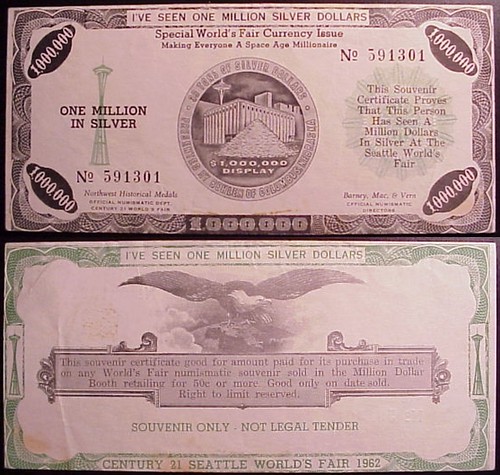
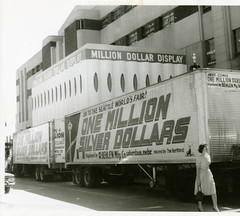
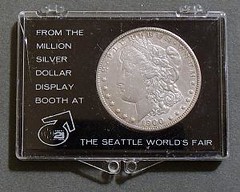
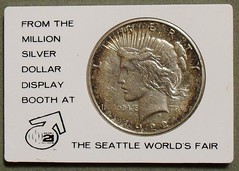
To read the complete thread on CoinTalk, see: Thread: 1962 Seattle World's Fair - Million Silver Dollars Exhibit - Slabbed Dollars Query (http://www.cointalk.com/t189919-3/)
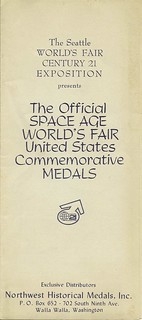


David Lange writes:
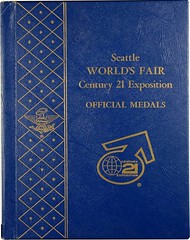 I have complete sets of the Century 21 Exposition medals in silver and bronze, including those for the million dollar exhibit of silver dollars. I didn't set out to buy the medals, but this was the only way to get the vintage Whitman Bookshelf album in which they were sold. I needed the album for my collection of same, and I bought the silver set first. I then bought a bronze set in its album, in case I wanted to unload the silver set, but I never did that. It turned out to be a good investment, as silver was only $12/ounce at the time.
I have complete sets of the Century 21 Exposition medals in silver and bronze, including those for the million dollar exhibit of silver dollars. I didn't set out to buy the medals, but this was the only way to get the vintage Whitman Bookshelf album in which they were sold. I needed the album for my collection of same, and I bought the silver set first. I then bought a bronze set in its album, in case I wanted to unload the silver set, but I never did that. It turned out to be a good investment, as silver was only $12/ounce at the time.
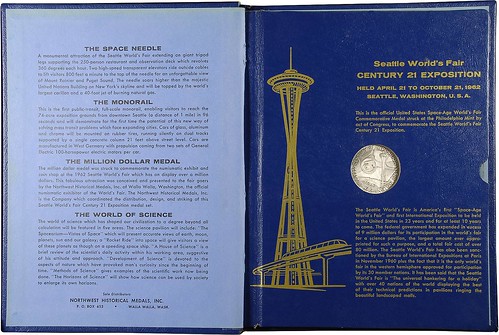
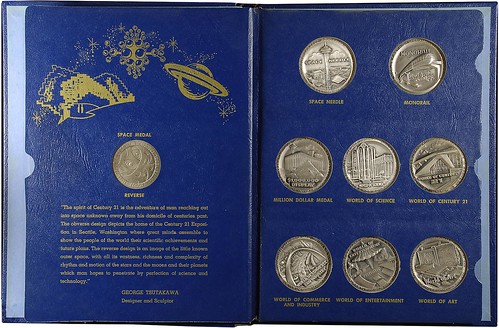


David adds:
While putting the medal back into its album, I noticed that the edge is stamped THE METAL ARTS CO. INC., ROCH., N. Y.
To read the earlier E-Sylum article, see: 1962 SEATTLE WORLD'S FAIR DOLLAR DISPLAY BROCHURE (http://www.coinbooks.org/esylum_v15n44a18.html)
THE BOOK BAZARRE
NOTES FROM E-SYLUM READERS: OCTOBER 28, 2012
H.D. Allen's Confederate Currency Research
George Tremmel writes:
As an update to your review, the 1917-19 H.D. Allen Numismatist articles were published in book form. In 1945, R. Green reprinted the 1915 William West Bradbeer work, Confederate and Southern State Currency. In the last part of the book (pages163-277) he also reprinted the Allen articles.
George Tremmel adds:
I agree that it’s unfortunate that Allen is not as well known as Bradbeer. His articles are important to students of Confederate financial history.
I'd also like to mention that Marty Davis and I (co-authors with Pierre Fricke on the 2010 Confederate Interim Depository Receipts book) have recently contracted with McFarland & Co. to publish a book titled Parole, Pardon, Pass and Amnesty Documents of the Civil War: An Illustrated History. This topic probably will appeal more to Civil War History buffs than to numismatic readers.
To read the earlier E-Sylum article, see: BOOK REVIEW: HISTORY OF COLLECTING CONFEDERATE STATES PAPER MONEY (www.coinbooks.org/esylum_v15n44a06.html)
More on the Copyright Symbol on Coins
Yossi Dotan writes:
The following coins issued by the Cook Islands feature a copyright symbol: KM-300, 100 dollars 1996, and KM-1095, 30 dollars 1999. Both are in .999 fine gold and have a colored reverse.
Unfortunately, I have no image for KM-300. It marks the Year of the Mouse. The reverse depicts Mickey Mouse sailboarding. The copyright notice © DISNEY is inscribed on the reverse at 9 o'clock.
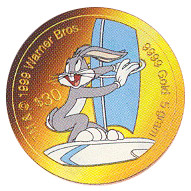 Attached is an image of the reverse of KM-1095 which I found in a publication of the Singapore Mint. It depicts Bugs Bunny windsurfing and bears the trademark and copyright notice ™ & © WARNER BROS. It was issued to mark the Year of the Rabbit.
Attached is an image of the reverse of KM-1095 which I found in a publication of the Singapore Mint. It depicts Bugs Bunny windsurfing and bears the trademark and copyright notice ™ & © WARNER BROS. It was issued to mark the Year of the Rabbit.
To read the earlier E-Sylum article, see: THE COPYRIGHT SYMBOL ON COINS (www.coinbooks.org/esylum_v15n44a07.html)
Centesimus Undequinquagesimal Anniversaries
Regarding Ron Abler's tongue-in-cheek item on 149th Anniversaries,
Martin Purdy writes:
I assume this is intended as a joke rather than a serious suggestion! The application of math to Latin and the chopping and mixing of word elements in this way just doesn't work. At the risk of taking the matter too seriously, "149th" in Latin would be "centesimus undequinquagesimus", so at a stretch I guess you could anglicize that to refer to a "centesimus undequinquagesimal" anniversary ...
To read the earlier E-Sylum article, see: VOCABULARY WORD: QUASQUIBIDUODECENTENNIAL (www.coinbooks.org/esylum_v15n44a08.html)
BILL ROSENBLUM'S NUMISMATIC TRAVEL TIDBITS
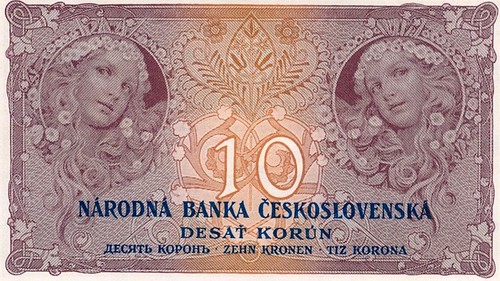
Rita and I just returned from a two week auto trip from Colorado to the East Coast and back. The main reason was to pick up some of items from my parents' house that my brother and I had taken from the house after my Mom died in June. We had left most of the "valuables" in my brother's garage and basement and hadn't had a chance to get back and go over the "stuff". Since we are having major remodeling work being done on our house we thought it would be a good time to get out of town.
As hard as it was for me we did not stop at any coin shops nor even call any numismatic friends. However we made short stops at some historical sites which of course had a numismatic connection, The Abraham Lincoln Museum and Library in Springfield, IL, Gettysburg PA and Mt. Rushmore. Obviously in our Abraham Lincoln adventure we saw plenty of Lincoln "Cents" in various sizes for sale. And at North American Indian Museum (I think that's the name) at Crazy Horse Mountain we saw at least two Indian Silver Certificates.
One place that we didn't expect to see numismatic relics was at the National Czech and Slovak Museum in Cedar Rapids, Iowa. They were having a major exhibition of Alphonse Mucha the famed Czech "Art Nouveau" artist. My wife loves his work and has numerous Mucha postcards in her collection. However I had never made the connection to his work and Czech banknotes but he designed a number of Czechoslovakian banknotes from the 1st republic formed after World War I. Always something to learn.
Today I came across this short article about somebody posing as a cop to get a better deal in the disposal of his coin collection. I probably wouldn't have paid any attention to it but this happened in Portage, Indiana, a town I was not even aware of until last week when we stayed there on our way home
To read the complete article, see:
Police: Man posed as cop for coin deal
(www.nwitimes.com/news/local/porter/portage/police-man-posed
-as-officer-to-get-better-deal-on/
article_27aea96c-f9fe-5ae2-8d9a-122618570a70.html)
LIBERTY DOLLAR FOUNDER VON NOTHAUS AWAITS HIS FATE
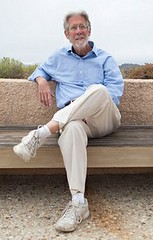 High above the cliff tops and the beach bars, up a winding mountain road, in a borrowed house on someone else’s ranch, an unusual criminal is waiting for his fate.
High above the cliff tops and the beach bars, up a winding mountain road, in a borrowed house on someone else’s ranch, an unusual criminal is waiting for his fate.
His name is Bernard von NotHaus, and he is a professed “monetary architect” and a maker of custom coins found guilty last spring of counterfeiting charges for minting and distributing a form of private money called the Liberty Dollar.
Described by some as “the Rosa Parks of the constitutional currency movement,” Mr. von NotHaus managed over the last decade to get more than 60 million real dollars’ worth of his precious metal-backed currency into circulation across the country — so much, and with such deep penetration, that the prosecutor overseeing his case accused him of “domestic terrorism” for using them to undermine the government.
Of course, if you ask him what caused him to be living here in exile, waiting with the rabbits for his sentence to be rendered, he will give a different account of what occurred.
“This is the United States government,” he said in an interview last week. “It’s got all the guns, all the surveillance, all the tanks, it has nuclear weapons, and it’s worried about some ex-surfer guy making his own money? Give me a break!”
The story of Mr. von NotHaus, from his beginnings as a hippie, can sound at times as if Ken Kesey had been paid in marijuana to write a script on spec for Representative Ron Paul. At 68, Mr. von NotHaus faces more than 20 years in prison for his crimes, and this decisive chapter of his tale has come, coincidentally, at a moment when his obsessions of 40 years — monetary policy, dollar depreciation and the Federal Reserve Bank — have finally found their place in the national discourse.
A native of Kansas City, Mr. von NotHaus first became enticed by making money while living with his companion, Talena Presley, without a car or electric power in a commune of like-minded dropouts in a nameless village on the Big Island in Hawaii. It was 1974, and Mr. von NotHaus, 30 and ignorant of economics, experienced “an epiphany,” he said, which resulted in the writing of a 20-page financial manifesto titled “To Know Value.”
In it he described his conviction that money has a moral aspect and that any loss in its value will cause a corresponding loss in social and political values. It was only three years after President Richard M. Nixon had removed the country from the gold standard, and Mr. von NotHaus, a gold enthusiast, began buying gold from local jewelers and selling it to his friends.
One day, he recalled, “we were all sitting around thinking, ‘Wow, we ought to do something with this gold.’ And I said: ‘Yeah, we could make coins. People love coins. We could have our own money!’ ”
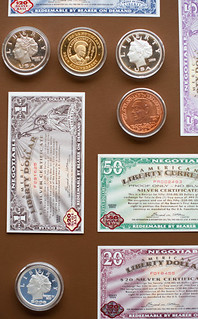 Within a year, he had established the Royal Hawaiian Mint, a private — not royal — producer of collectible coins. Hitchhiking to a library in the county seat of Hilo, he said, he looked up “minting” in the encyclopedia and soon was turning out gold and silver medallions with images of volcanos and the Kona Coast.
Within a year, he had established the Royal Hawaiian Mint, a private — not royal — producer of collectible coins. Hitchhiking to a library in the county seat of Hilo, he said, he looked up “minting” in the encyclopedia and soon was turning out gold and silver medallions with images of volcanos and the Kona Coast.
So went the better part of 20 years. Then came 1991, which saw the emergence of a successful local currency in Ithaca, N.Y., called the Ithaca Hour. The 1990s were a time of great ferment in the local-money world with activists and academics writing books and papers, like Judith Shelton’s “Money Meltdown.” Mr. von NotHaus, traveling with his sons, Random and Xtra, to adventuresome locations, like Machu Picchu, read these seminal works.
“I had been working on it since 1974,” he testified at his federal trial in North Carolina. “It was time to do something.”
To read the complete article, see:
Prison May Be the Next Stop on a Gold Currency Journey
(www.nytimes.com/2012/10/25/us/liberty-dollar-creator-awaits
-his-fate-behind-bars.html)
LIBERTY DOLLARS VS COMMUNITY CURRENCY
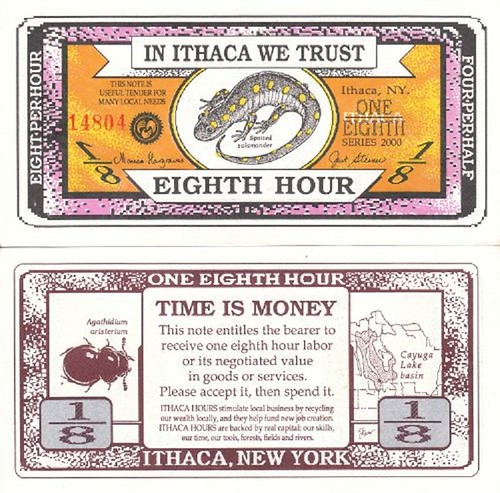
Occasionally there are attempts to intimidate independent currency issue. Bernard Von Nothaus was convicted in 2011 for issuing Liberty Dollars, coins backed by silver that significantly resemble United States money.
Lawyer Bill Rounds replied, “Congress [has] the power to punish counterfeiting the coins that they themselves produce, and probably to punish coins resembling genuine United States coins. Again, there is absolutely no mention of private coinage. In fact, the definition of private coinage is that it is not the current coin of the United States. Therefore, Congress has no authority over private coinage at all and neither does any other branch.”
The book “Rethinking Or Centralized Monetary System: the Case for Local Currencies” by Lewis Solomon, professor of legal research at George Washington University, details legal precedent.
Here is a sample letter to be signed by a congressmember from the Ithaca area. It can be sent to any official who threatens free trade.
Dear _____________,
We understand that you have considered drafting a law that could prohibit all private monies, believing that, like Liberty Dollars, they challenge the primacy of Federal Reserve Notes.
I’d like to offer certain distinctions between Liberty Dollars and various community credit systems with which I am familiar.
Liberty Dollars confronted the United States seignorage privilege by minting gold and silver coins, using the same mottos, declaring these dollars, and seeking to replace the United States dollar nationwide.
Within my district (NY-26), by contrast, we have seen significant economic benefits by trading Ithaca HOURS.
This taxable paper currency, valued at $10/hour of basic labor, has facilitated millions of dollars of trade among thousands of individuals and over 500 businesses.
The stability of a national currency depends ultimately on the vitality of village and neighborhood economies. Therefore, HOURS strengthen the United States dollar by bringing into productive use many local skills and much time that is not employed by the formal economy. And by so doing the network serves as an incubator for new businesses and jobs. Moreover, this supplemental currency has created discretionary income that has stimulated further millions worth of taxable transaction in the retail economy.
Ithaca HOURS, in six denominations, look entirely distinct from Federal Reserve Notes. This colorful cash features local children, waterfalls, trolley cars. Issuede within a 20-mile radius, they serve as a local boost to dollar trade, not a national replacement.
Among their advocates are the Tompkins County Chamber of Commerce. HOURS have been reviewed favorably by the Wall Street Journal, Forbes, Business Roundtable, and the newsletter of the Federal Reserve Board of Cleveland. The public voice of HOURS for several years was a former economics professor and Federal Reserve researcher, who managed accounts for the International Monetary Fund.
There are many other types of supplemental credits circulating in our country. Disney Dollars transact in the Magic Kingdom. Thousands of merchants nationwide issue promotional store notes, and many downtown districts issue Downtown Dollars. There are vairous online credit systems like LETS (Local Economic Trading System) and ITEK business-to-business credits, whose transactions may be accessed by the IR for taxation.
They are mere modest mortar reinforcing the brick walls of capital. Indeed, their aim is not to replace dollars, but to replace lack of dollars.
Such currencies are approved in many other countries worldwide, from Germany and France and Britain, to Thailand, Argentina and even the People’s Republic of China. The Swiss trade nearly $2 billion of WIR yearly, among 60,000 businesses.
Multinational corporations exchange promissory notes for multimillion-dollar-value barters. An estimated half of global commerce is cashless.
Our Federal government’s greater concern should be taxability. I believe that if swapping printed jelly beans adds to federal revenue we should not restrain that trade.
Yours,
____________
ATTORNEY CAN FILE SUITS AGAINST GRADING SERVICES
A coin collector who invented an "eye appeal" grading method can sue companies that he says broke their deal not to use his ideas as their own, a federal judge ruled.
Duane Blake, attorney and coin collector, calls his method to grade the "eye appeal" of coins the "axial ultimate refractory angle of the coin" (AURA). A coin's grade reflects its condition and authenticity, and helps to determine its value.
Blake pitched his method to several coin-grading companies, including Professional Coin Grading Service, Collectors Universe and Numismatic Guaranty Corporation of America. He says he proposed that coin labels include a plus sign for an above-average AURA rating.
He also proposed taking a digital photo of the coin during the grading process, so collectors could track any alterations made to the coin's condition.
While the associations declined to work with him, Blake says that Professional Grading and Numismatic jointly launched a plus designation within their own grading system, despite their non-disclosure agreement with Blake.
Though U.S. District Judge William Young rejected Blake's claim to own the plus designation, he said Blake can advance claims that the coin associations stole his marketing ideas.
To read the complete article, see: Collectable Coin Graders Can't Toss Inventor's Suit (www.courthousenews.com/2012/10/22/51521.htm)
NEW LAWSUIT AGAINST NATIONAL GOLD EXCHANGE OWNERS
Mark and Alan Yaffe, brothers accused of misappropriating millions in gold coins, are facing another lawsuit.
The Yaffes formerly operated a gold and rare coin company in North Tampa called National Gold Exchange. Their business was embroiled in controversy in 2009 when Sovereign Bank — to whom the Yaffes owed millions — got a tip that they were improperly using some of National Gold's assets.
When the bank performed an accounting of National Gold, it discovered millions of the business' rare coins were missing. The bank sued, and the gold company eventually was liquidated in bankruptcy court. Mark Yaffe has been trying to sell his 29,000-square-foot mansion in Avila to pay off his creditors.
Now two men are claiming the Yaffes misappropriated their money.
This month, Gene Sanders, of Crete, Ill., and Kirk Kelly, of Greenville, S.C., filed a lawsuit in Hillsborough County Circuit Court against the Yaffes and other parties related to them. Sanders and Kelly claim Mark Yaffe offered in 2009 to let them in on a deal involving rare European coins.
Basically, Yaffe and the two men would purchase the coins from Europe, sell them immediately to gold dealer Goldline International and split the profit. Eventually, Sanders and Kelly provided Yaffe with about $1.05 million in cash and rare coins to make the purchase, according to the suit.
However, the men never received their share of the money, their lawsuit states. Instead, Sanders and Kelly allege that the Yaffe brothers diverted their money to a side business and still carried out the European coin deal, unbeknownst to Sanders and Kelly.
To read the complete article, see:
Bankrupt Tampa gold dealers sued
(www2.tbo.com/business/business/2012/oct/23/mebizo1-bankrupt
-tampa-gold-dealers-sued-ar-541162/)
STACKS-BOWERS NOVEMBER 2012 BALTIMORE AUCTION LOTS
Lot 50: John Paul Jones Naval Medal Obv: JOANNI PAVLO JONES CLASSIS PRAEFECTO. COMITIA AMERICANA. (THE AMERICAN CONGRESS TO JOHN PAUL JONES, COMMANDER OF THE FLEET) with bust to right. Rev: HOSTIVM NAVIBVS CAPTIS AVT FVGATIS (THE VESSELS OF THE ENEMY CAPTURED OR PUT TO FLIGHT) above scene of naval battle. AD ORAM SCOTIAE XXIII.SEPT.M.DCCXXVIIII (AT THE SHORE OF SCOTLAND, SEPTEMBER 23, 1779) in exergue. Engraved by Augustin Dupre, in Paris. This medal reveals an exquisite design , with amazingly fine details of the warships on the reverse, especially the central ship with its multiple masts and sails. The surfaces are reflective and the motifs are reproduced in high relief, with razor-sharp definition. Rich copper-tan patina increases the enticing visual quality of the piece. A scarce, highly desirable specimen of the first naval medal authorized by Congress (originally struck in gold).
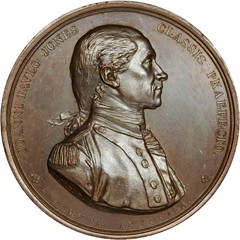
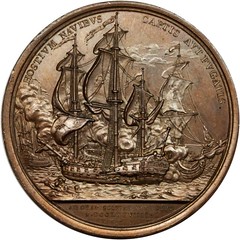
To read the complete lot description, see: stacksbowers.com/Auctions/AuctionLot.aspx?LotID=410205
Lot 105: "Long Live The King" Engraved Button 36mm. Original shank. This highly elusive George Washington Inaugural related button exhibits bold central obverse details exceeding that of the finest offered at auction, the Cobb Collection sold by us (Stack’s) in our 2003 Americana Sale, lot 1326, which brought $14,950. The bright silver obverse retains most of its original “silvering” or “tinning” with some dark copper present where the silver has rubbed off, mostly at the peripheries. The plain back side has an even natural brown patina, and the original shank is intact, though pushed down flat. It is likely among the finest extant of this rare and seminal type that is collected along with and as part of the Washington Inaugural Button field. The design type has been described as related to George III’s 1789 recovery from his bout with porphyria, though this legend and its message could have also come from an earlier decade. Two such buttons are reported to have been found in America, one in Brooklyn and another in Maine. The size and legend of this button type could easily have inspired the design and style for the 1789 Washington Inaugural buttons bearing the legend “Long Live the President,” and these Long Live the King buttons are avidly collected by Washington Inaugural button collectors as such.
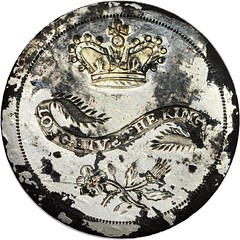
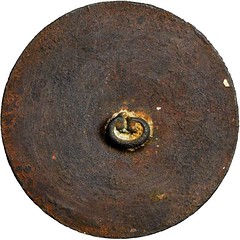
To read the complete lot description, see: stacksbowers.com/Auctions/AuctionLot.aspx?LotID=410260
Lot 322: 1860 Edward Cogan. Miller Pa 90G. Silver. Plain Edge.
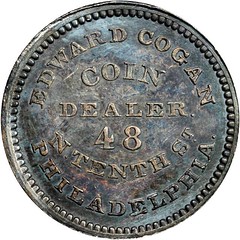
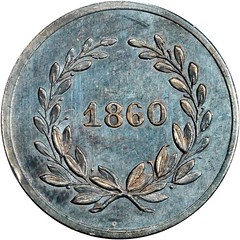
To read the complete lot description, see: stacksbowers.com/Auctions/AuctionLot.aspx?LotID=410476
Lot 6869: End Of Pain / Knave Halfpenny Conder Token A Gem-quality example of this popular Thomas Paine issue, the obverse design with the inscription END OF PAIN around a man hanging from a gallows, with a church to the right. Otherwise medium brown surfaces reveal glints of original pinkish red luster in the protected areas around a few of the devices as the token rotates under a light. British-born Paine was a political activity and revolutionary who became one of the founding fathers of the United States.


To read the complete lot description, see: stacksbowers.com/auctions/AuctionLot.aspx?LotID=410025
Lot 4281: BEP Presentation Book. The Presidents Of The United States
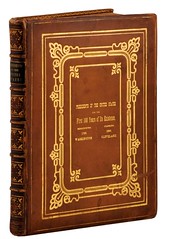
Octavo, nearly square format. 22.0cm by 17.5cm by 1.5cm. Full, brown morocco with deep polishing. Gilt front and back edge bordering and interior pattern. Intricate cover titles in three lines with additional BEGINNING/ 1789 /WASHINGTON and to the right CLOSING /1889 /CLEVELAND. Gilt titled: PRESIDENTS /OF THE/ UNITED /STATES on spine. Five raised spine bands with pattern compartments. Inside covers red marbled paper, leather turned inwards straight. 24 intaglio India paper proof vignettes on original gilt edged cards by the BEP, some titled, some not. Includes all 22 of the Presidential portraits from Washington to Grover Cleveland. The frontis has additional Washington vignette in classical Roman style and title page vignette of the Treasury Building. The first we have seen with this binding and cover titles.
To read the complete lot description, see: stacksbowers.com/Auctions/AuctionLot.aspx?LotID=395894
Lot 4327: New York City. Mendum’s Family Wine Emporium Obsolete Notes. New York, New York City. Mendum’s Family Wine Emporium, Related. Issuer Of Encased Postage Stamps. Four Colorful Small Scrip Tickets, Circa 1862, Issued For Mendum’s Branch, Wine And Ale Vaults, 55 William Street, Corner Pine. Wm. Davis, Proprietor.
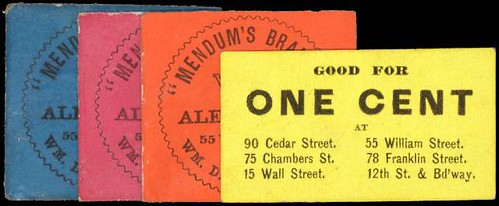
To read the complete lot description, see: stacksbowers.com/Auctions/AuctionLot.aspx?LotID=395940
WHERE WAS THE CONTINENTAL CURRENCY COINAGE MADE?
Last week Bob Leonard speculated that coinage of the pewter dollars could have taken place as late as 1778 or 1779, with the date of 1776 used in honor of the Declaration of Independence. He referenced an item from the Nova-Scotia Gazette & Weekly Chronicle for Jan. 4, 1780.
So far no one has responded to my question of who made the Continental coinage. Elisha Gallaudet is thought to be the engraver, but evidence is scant. Are there punch linkages, stylistic cues, or other connections to work known with certainty to be from the hand of a particular engraver of the period?
Andrea Grimason came across the following definition of "Continental Currency" in the online Merriam-Webster's dictionary:
: the paper money issued by the Continental Congress during the American Revolution
: a series of early American pattern dollar-size coins, struck in England in pewter, silver, and brass and bearing on the obverse the legend “Continental Currency” and the date 1776
To read the complete article (behind a paywall), see: www.merriam-webster.com/dictionary/continental%20currency
I bolded the interesting phrase here: "struck in England in pewter, silver, and brass". In terms of credibility Merriam-Webster is perhaps a step above much of what other information can be found on the Internet, since presumably some scholar of good reputation wrote or reviewed the entry. But where did that information come from? Does anyone know of an original source which attributes the coinage to England?
To read the earlier E-Sylum article, see: ON THE ORIGIN OF THE CONTINENTAL DOLLAR (www.coinbooks.org/esylum_v15n44a11.html)
BLESSED ARE THOU, BIBLIOGRAPHY

I appraised a fairly rare medallic item this week for the owner and ended up writing a 15-page document. My appraised value was under $1,000; as such it did not deserve such a lengthy dissertation.
But I got carried away. I could not find any recent auction sales of this item or similar items by the same artist. So I increased my effort. I overcompensated by digging deeper, finding dozens of published references.
The deeper I dug, however, the more interesting became the story about the item, the portrait subject, the artist, how it was made and who made it. I learned of two collectors who had this item in their collections, and five public museums.
The Smithsonian Numismatic Collection and the American Numismatic Society both had the item in their collections. The others were specialized museums. It was not diestruck, but was an electrogalvanic cast (a “galvano” made by one of the founders of Medallic Art Company, this strengthened my research resolve).
I attached a list of the 24 published works I located with related data on the item and its artist. I didn’t call it a “bibliography.” Now it is éclat to call it “Resources.” Call it what you wish I hope the client tracks down some of these published citations. This will give him as much reading pleasure, I’m certain, as I have enjoyed, uncovering them.
But it brings to mind the importance what has been previously published about a subject – any subject. The first thing a writer should do when approaching a fresh writing chore is DO A LITERATURE SEARCH.
There are numerous aids for book search and subject search these days. I rely on my own library and my own voluminous files first. Then I turn to ABEBOOKS, the library catalogs of the two numismatic organizations, American Numismatic Association, ANS, then GOOGLE, then …[think for yourself, where would you look?]
When I have tracked every lead, checked out every bibliography in those books I turn to live people.
I start asking myself who has special knowledge of this subject or this numismatic item. It’s called ASK THE EXPERT. I find dealers often have extensive specialized knowledge. A brief inquiry often brings the most enlightening response. Dealers – if they have the spare time – delight in showing off how much specialized knowledge they do indeed possess.
But don’t be a pest. Don’t come back with twenty questions. Dig into the literature. If you wish, send that dealer a summary of what you have learned later and ask if you have overlooked anything.
And don’t overlook adding a list of books, articles, manuscripts, internet references, everything related to the subject you wrote about, in your own writings. Be sure to add a Bibliography, Dude!
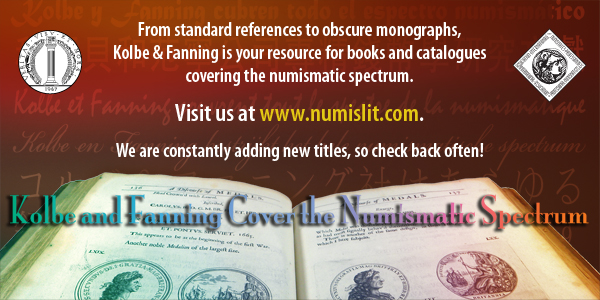
FAIRBANKS NATIONAL BANK NOTE SELLS
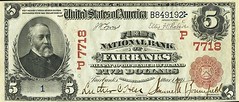 This isn't just any old $5 bill. A collector paid almost $247,000 for the rare, century-old note.
This isn't just any old $5 bill. A collector paid almost $247,000 for the rare, century-old note.
The 1905 bill from the First National Bank of Fairbanks, Alaska, sold at a Thursday auction by Dallas-based Heritage Auctions.
Heritage spokesman Dustin Johnston declined to name the buyer, saying only that the bill's new owner lives in the lower 48.
The bill was presented in 1905 to Vice President Charles W. Fairbanks, the namesake of the Alaska city and Theodore Roosevelt's No. 2.
The bill has been in the family's possession since. Charles W. Fairbanks IV of California, the vice president's grandson, recently decided to auction it.
To read the complete article, see:
Century-old $5 Alaska bill sells for nearly $247,000
(www.newsminer.com/view/full_story/20577292/article-Century
-old--5-Alaska-bill-sells-for-nearly--247-000-?instance=home_lead_story)
Jess Lipka was exhilarated at the chance of owning the rare $5 bill, even though his winning bid of nearly $247,000 terrified him.
"It's a lot of money," the Old Flemington, N.J., man said Tuesday. "I have to move around a lot of things and figure out how to cover it."
But he was determined to have the century-old note issued through the First National Bank of Fairbanks. Thus his steep bid at an auction by Dallas-based Heritage Auctions last week at the American Numismatic Association National Money Show.
Lipka, 51, is a coin and currency dealer, but he said the 1905 bill is for his private collection of old national bank notes of a category known as Serial No. 1 red seals. The note represents one of the few states missing from his cache, said Lipka, who has collected national bank notes for most of his life.
Lipka's bid was the most he's ever paid at auction, he said. But now he has the note he first heard about more than 20 years ago.
"It's a great privilege, one of the highest privileges I've ever had, to own a great piece of Alaskan history," he said.
The proceeds for the sale will go toward ongoing restoration work of the historical Fairbanks House in Dedham, Mass, according to the great-grandson. The house, open to public tours, was built in the 1600s and is believed to be the oldest standing timber house in North America, according to the Fairbanks House website.
Fairbanks, 67, said he met Lipka at the Dallas auction and was glad to see him become the new owner of what was long a family heirloom. There's no doubt Lipka knows his currency, Fairbanks said.
To read the complete article, see: N.J. man adds rare $5 Alaska bill to collection (www.newsminer.com/view/full_story/20588092/article-N-J--man-adds-rare--5-Alaska-bill-to-collection-)
Dick adds:
Lyn Knight has a $5 red seal in his Nov. 8-10 sale. It is not a #1. It will be interesting to see what that one sells for! Ron Benice says there are 33 $5 red seals accounted for.
Three of the original four notes from the #1 sheet have survived: The one in Heritage, one in an Alaskan collection, and one at the University of Alaska Museum of the North.
To read the earlier E-Sylum article, see: ALASKA NATIONAL BANK NOTE MAKES HEADLINES (www.coinbooks.org/esylum_v15n42a22.html)
OREGON TOWN USED TOKEN TO RELIEVE 1964 COIN SHORTAGE
 In 1964 the value of silver was frozen by the Treasury at $1.293 a troy ounce. At any higher price, the silver in a silver dollar would be worth more than face value. The public expected that it would be only a matter of time before this threshold would be crossed and began to hoard silver coins of all denominations.
In 1964 the value of silver was frozen by the Treasury at $1.293 a troy ounce. At any higher price, the silver in a silver dollar would be worth more than face value. The public expected that it would be only a matter of time before this threshold would be crossed and began to hoard silver coins of all denominations.
This in turn caused a coin shortage. On July 23, 1965, Congress enacted the Coinage Act of 1965, which eliminated silver from the circulating dimes and quarter dollars of the United States and diminished the silver content of the half dollar from 90 percent to 40 percent.
This piece of legislation had far reaching consequences; ironically the most immediate was to increase the coin shortage.
Now go back to 1959 and the state of Oregon. That year marked the centennial of Oregon statehood and plans were made to celebrate the occasion in a big way. A token was designed and samples struck with a common obverse depicting the official centennial logo with the reverse to be determined by the participating municipalities. The plan was for cities and counties to purchase the tokens to sell to their residents as souvenirs. This revenue would be kept by the municipality to offset the expense of their local celebrations.
These trial strikes were promoted throughout the state. In all, to the best of my knowledge, 34 cities and counties bought into the program, most using the official logo obverse, but a few went with their own designs on both sides. There was even one token produced for an Oregon coin club and one for a private individual. The tokens were 33mm in diameter, the standard version produced in gilt bronze, but some of the municipalities went with an additional variety in silver plate. The mintages ranged from 1,000 to 30,000 of any given example. This makes for a good-size collection if one wishes to obtain a complete set.
I started a type collection six months ago with the intent of acquiring one sample of each design without regard to all the varieties. I have 11 left to find. So at this point you might be asking what do the Oregon centennial tokens of 1959 have to do with the coin shortage of 1964?
In the southern part of Oregon is a town called Grants Pass, which participated in the token program of 1959. They purchased 20,000 of them. They were one of the municipalities to go with their own design on both sides. The obverse is unique and would be a story itself. The reverse promotes Grants Pass, proclaims the token to be good for 50 cents in trade or redeemable at face value at local merchants and gives an expiration date. It is unknown how many they sold, but there was evidently a surplus when the party was over. This surplus sat collecting dust until 1964.
When Grants Pass began to feel the effects of the coin shortage, someone got the bright idea to put the surplus tokens into circulation at the stated value of 50 cents. The only problem was the stated expiration date of 5 P.M. SATURDAY OCTOBER 31, 1959. The solution was to grind off the expiration date to avoid confusion and then release the tokens into circulation.
I cannot tell you which version is the rarer of the two, but it is a certainty that two versions of this token exist as a direct result of the 1964 coin shortage.
To read the complete article, see: Coin Shortage Creates Token Tale (www.numismaster.com/ta/numis/Article.jsp?ad=article&ArticleId=26011)
MORE ON THE ST ALBANS ROMAN GOLD COIN HOARD
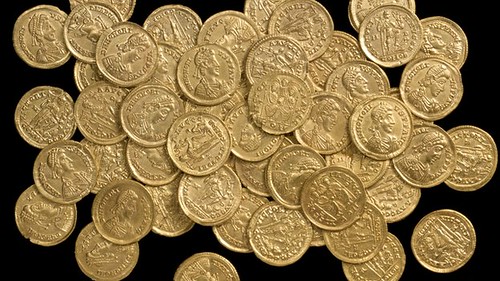
Courtesy of David Thorold of St Albans Museum and Richard Abdy of the British Museum I can now give this preliminary breakdown of the legible coins.
The joint reign of Gratian, Valentinian II and Theodosius I (AD 378/9-383)
Gratian – 1
Theodosius – 4
Valentinian II – 2
The family of Theodosius I + Valentinian II (AD 383-392/5)
Theodosius – 3
Valentinian II – 9
Arcadius – 4
The joint reign of Arcadius and Honorius (AD 395-408)
Honorius – 95*
Arcadius – 38*
Unknown emperor – 3 (require further cleaning)
* = includes coin with illegible reverse (prior to cleaning) which could also be of previous group
Harold Levi writes:
I am going to show my ignorance, which has never been difficult for me to do. The hoard coins in the image seem to be consistent in size and diameter. Did they use collar dies back in circa 400?
To read the earlier E-Sylum article, see: ROMAN GOLD COIN HOARD FOUND IN HERTFORDSHIRE (www.coinbooks.org/esylum_v15n44a23.html)
To read the earlier E-Sylum article, see: ROMAN GOLD COIN HOARD FOUND IN HERTFORDSHIRE (www.coinbooks.org/esylum_v15n44a23.html)
THE MINT MUSEUM AT HALL IN TYROL
 Hall in Tyrol. We have to spell it completely in order to avoid any confusion. After all there are many towns sounding quite similar to the English speaking world: Hallein, Hallstadt, Reichenhall, Halle, Schwäbisch Hall. They all share one aspect: In all these places salt was mined, and in the Middle Ages “hall” was the German word used for salt.
Hall in Tyrol. We have to spell it completely in order to avoid any confusion. After all there are many towns sounding quite similar to the English speaking world: Hallein, Hallstadt, Reichenhall, Halle, Schwäbisch Hall. They all share one aspect: In all these places salt was mined, and in the Middle Ages “hall” was the German word used for salt.
The Hall salt pans were mentioned for the first time in 1232. The counts of Tyrol – first the Meinhardiners, then the Habsburg – invested in this place creating thus their wealth which would lead to their ascent. At this epoch salt was considered the white gold since it was the only way of curing meat and fish, being therefore one of the paramount resources of the pre-refrigerator epoch.
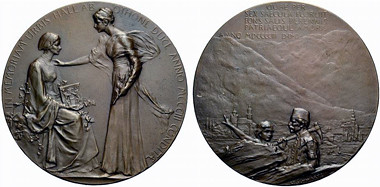
Hall in Tyrol. Medal 1903 by Stefan Schwartz
Hall was a prosperous city, owing its wealth not only to the salt but also to the trade. There, the merchants were able to cross the River Inn over a bridge, and the river was navigable right up to Hall. Two important fairs took place in Hall, and since 1486 there was the mint where silver from the neighboring Schwaz was transformed into coins. In this golden age, Hall was approximately twice as big as nearby Innsbruck.
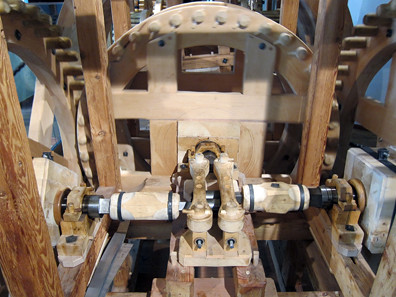
Rolling Mill Hall Mint Museum
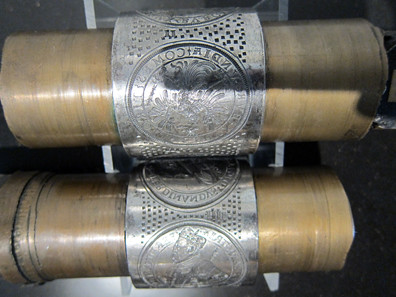
Roller Dies Hall Mint Museum
At Hasegg Castle the mint had been accommodated since the sixteenth century. Today it houses a unique museum of minting technology where the visitors can admire a great number of original minting machines and replicas. An audioguide in several languages gives particularly thorough information at hand and is, therefore, of special interest for coin collectors who go there with their family. Indeed they offer a special children version as well that gives an understanding of the objects in an age-appropriate and at the same time intriguing way.
To read the complete article, see: A trip to Hall in Tyrol (www.coinsweekly.com/en/News/4?&id=1557)
AFGHANISTAN BOMB-DETECTING DOG WINS DICKIN MEDAL
 A working dog that saved soldiers' lives in Afghanistan by detecting roadside bombs and even an underground militant hideout was on Thursday awarded a posthumous medal known as the 'animal Victoria Cross'.
A working dog that saved soldiers' lives in Afghanistan by detecting roadside bombs and even an underground militant hideout was on Thursday awarded a posthumous medal known as the 'animal Victoria Cross'.
Theo, a springer spaniel, died in March 2011 of a seizure hours after his handler, Lance Corporal Liam Tasker, was killed by enemy fire.
Tasker's relatives attended a ceremony Thursday at London's Wellington Barracks for the presentation of the PDSA Dickin Medal, awarded to animals by the veterinary charity for "conspicuous gallantry or devotion to duty while serving in military conflict".
Tasker's mother, Jane Duffy, described Theo as her son's "best mate" and said they were together "24/7" in Afghanistan.
She went on: "Liam got his mention in dispatches, so it's lovely that Theo is getting his PDSA Dickin Medal and he's being recognised for his bravery as well.
"They'll be watching us and they'll be so proud. I just wish they were here to get it themselves. Theo and Liam saved so many lives out there."
To read the complete article, see:
Hero dog wins 'animal Victoria Cross'
(www.google.com/hostednews/afp/article/ALeqM5jfXML7shyv
1JcUpeRn_GYn0jY8PA?docId=CNG.e948f75582c629a7eb61956930e63223.701)
To read the complete article, see:
Recipients of the PDSA's Dickin Medal, the animal version of the Victoria Cross
(www.telegraph.co.uk/news/picturegalleries/howaboutthat/
9634169/Recipients-of-the-PDSAs-Dickin-Medal-the-animal
-version-of-the-Victoria-Cross.html)
THE COLLECTING ADDICTION: A NEW COLLECTOR IS BORN
I think ANY type of collecting, once it reaches a certain level, is really an addiction -- but unlike being addicted to drugs or alcohol, the money that we spend on the coin addiction is not gone once we get our "fix" -- those coins will probably be sold for a profit somewhere down the road, and we will have years or decades of enjoying them!
One of my oldest friends, an ER physician with a real scientific turn of mind could never understand collecting coins. Trying to explain why this variety was rare and worth $10,000 but this variety, which it looks an awful lot like, is common and worth $25 was just something he couldn't grasp. Nor could he understand stretching to buy a coin you really wanted, even if it meant cutting back on something else in life in order to do so.
About 10 years ago we were in England together and went to an antique show at my insistence because there were supposed to be some coin dealers in attendance. While we walked around I saw a dealer that had a cool old, large skeleton key and a neat old corkscrew, both kind of rusty, both priced at 10 Pounds apiece. A perfect souvenir, I decided I would buy one and that he should buy the other.
He hemmed and hawed and said he didn't want a rusty key or a corkscrew. But he lives up near Napa Valley and he enjoys wine, so I thought the corkscrew would be perfect for him....and told him that if he didn't buy it, I was going to buy it and give it to him for a Christmas present -- so either way, he was going to get it. He grumbled and bought it.
Fast forward to today -- he now has the third or fourth best corkscrew collection in the WORLD, with several thousand items. He's gone so far as having custom display cabinets built for them in his home, and he rotates what is on display in the collection every few months.
He now understands things that he never did about coins -- condition, rarity, variety, pricing, counterfeits, all sorts of minutiae of detail and, most important, the thrill of the hunt. This person who NEVER collected anything in his life is now a very happy addict (his wife is not quite as happy, but she would much rather have him chasing corkscrews than other things, I'm sure!).
I can understand how crazy collectors look to the rest of the world. I just had to laugh when I heard an NPR interview with the author of The Cursing Mommy's Book of Days, where the Mommy' husband spends hours upon hours finding, acquiring, and organizing his collection of antique capacitors. Me, I've got a bag of sales tax tokens stuffed in my desk drawer. -Editor
A BENCH MADE FROM BOOKS

To read the complete article, see: Bench made from books (boingboing.net/2012/10/24/bench-made-from-books.html)
FEATURED WEB PAGE: FORGERY NETWORK
This week's Featured Web Page is ForgeryNetwork.com, suggested by David Lange. Thanks.
This is a collective effort to build a resource to easily authenticate our collectable items. Please Register and upload items you know are not authentic.

www.forgerynetwork.com

